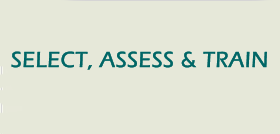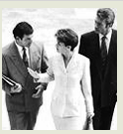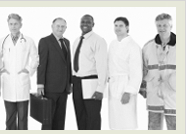Management Styles
Supervisory Approach
Management - Misc.
Communication-Verbal/Listening
Communication - Non-verbal
Creative Process
Creativity
Staff Motivation
Problem Employees
Personal Crisis -Indicators
Work Related Values &
Work Environment
Meetings
Presentations
Marketing Assessment
Prospecting
Customer Service
Management Files - main mage
|
|
COMMUNICATION
Silent Approval: Indicators / Signs | Body Language of Leaders | Body Language
Eye Movements | Height |
Eyes | Hands | Women
Non-Verbal Communication
— Studies show that during interpersonal communication
- 7% of the message is verbally communicated
- 93% is non-verbally transmitted
— Of the 93% non-verbal communication:
- 38% is through vocal tones
- 55% is through facial expressions
— We are educated to prefer words to communicate.
Therefore, we can overlook non-verbal signals.
— Foot movements, voice variations, facial expressions are all forms of non-verbal
communications that individuals send to each other.
We may not verbally call someone stupid/dumb, but we may send the message
non-verbally without realizing it.
— Body language is the oldest language. Often there is a discrepancy between
someone's words and their physical actions.
Confusion often occurs regarding what is heard or the message seems to
be mixed. Usually in these instances, the verbal and messages are in conflict.
— When in doubt experts say to trust the non-verbal message -- what you see.
— Words can be manipulated, but gestures are harder to control.
Silent Approval: Indicators / Signs
— Discovered by Dr. Albert E. Scheflen. who noticed the phenomenon while
studying people conversing in small groups.
— Observe the way people sit or stand while talking with others.
— If the person shifts position, the others, in agreement, are likely
to quickly to do the same.
— Experiment:
- Next time your speaking, try to notice who among your listeners is sitting
or standing in the same position as you are.
- Then try changing your position (i.e. crossing your leg, folding / unfolding
your arms...
- Those who match your body positioning, are silently signaling their approval
or agreeement.
- More vigorous approvals include nods and pursing of lips.
Body Language of Leaders
— Studies have shown that people in power appear large, strong with
relaxed posture.
— Superiority is signaled by:
- Sitting while others stand
- Lean back in their chairs
- Expansive gesturing
- Talking more, in louder voices
- Interrupt others
— People see you.....not your credentials.
— Non-verbal signals can give you a head start.
- Good posture identifies you as someone with something to say.
- Stand tall, flex knees and pull rib cage up.
- Look directly at the person / people you address -- no matter how many.
— It is the most remembered element in forming an impression.
— But do not stare --- 5 to 7 seconds maximum. (Various cultures differ)
— Make sure to focus on the eyes and not stare at the mouth or off to side.
Body Language
— Studies have shown that people generally stiffen / "freeze up" when lying.
The person who barely moves while speaking should be suspect.
— Defensive and rejection postures include:
- folded arms
- crossed legs
- body turned away from speaker
Height
— A basic tenet of the psychology of perception is that size is associated
with power.
— Whatever the mind judges as important, eye will judge as large.
— Therefore anyone who looms large in the mind is liable to be perceived large
in your eyes.
— Psychologist find that height can have impact on interaction.
— Smaller people may have a feeling of jeopardy which may make them wary of
or defensive around taller people.
— A study by Sidney Portney, psychologist, found that among themselves smaller
probably had little trouble agreeing on the issues presented to them.
But when taller men were added to their group, they grew noticeably ill at ease
and argumentative.
— Tall women, on the other hand, are caught in a gap in American values.
- On one hand, femininity has traditionally been associated with daintiness.
On the other hand, the culture says bigger is better.
- Tall women quickly discover that smaller individuals of both sexes assume
they are strong.
- In business, this perception of "power" (from being tall) can be a
doubled-edged sword.
- Subordinates will respect their "power," while superiors may feel threatened.
- Clients may be intimidated and/or overwhelmed and therefore may back away.
Eyes
— You are always communicating, and non-verbal communications is always
revealed in the eyes.
— Eyes, it appears, are always "talking" and providing valuable clues.
- Normal eye contact means communication is open.
- Looking down, often rejection.
- Avoiding eye contact suggest someone does not feel secure or included.
- A stare can mean dislike.
** Keep in mind cultural differences
Eye Movements
— Research has shown that eye movement can indicate a lot about the person
talking.
— Person may be sincere if:
- Eyes move upward --- stories about the past.
- Eyes move side to side --- observations about the present.
— But, if:
- Eyes constantly move upward when talking about present
--- delivering a prepared, memorized speech
- Eyes move from side to side when talking about past
or recalling facts and information.
--- likely to be liar or con-artis
- Eyes never move upward to retrieve information.
--- likely to be making it up.
Hands
— Since few movements of the hands, fingers and arms are directly related to
what is going on the the mind, it can reveal what another person is thinking.
Scientists observed that there are more nerves between the brain and hands
than any other portion of the body.
- Calm, confident and self-assured:
Hands move little or may hang limply at person's side or rest gently if sitting.
-OR-
- Limp or hanging hand could signify a boredom, restlessness or tiredness.
Depending on situation, it can also indicate frustration/digest.
- Picking or biting is common in tense situations.
- Hand held flat with palm outward or usually symbolizes "I do not know..."
- Hands that are quite active: person is usually jittery, nervous or uneasy.
- Clenched hands often mean tension and frustration, even anger.
— If a person is about to say something or wants to say something... there is
a tendency to raise a finger slightly.
- Shy or timid individuals may not get past this stage. Pushy/ aggressive
people often preceive this as a sign of weakness that they can push aside
or go around.
— A raised or slightly raised finger, usually used by those to authority, is used
as a sign of warning.
— When this is not forceful and the finger/hand is only slightly raised
usually indicates uncertainity.
Women
— The challenge of being taken seriously...the body language learned growing
up is often "apologetic." This will not lend to being takenseriously and moving
into leadership positions.
— In business, women must appear assertive:
- Stand akimbo (legs positioned a bit apart) with hands on hips.
- In workplace, keep hands on arm rest of chair, not on lap.
- Cross legs (relaxed), not tense and "glued" together.
- Use expansive gesturing, from elbow.
- Do not back away if challenged. Maintain eye contact and "hold" ground.
- Be careful of moves that may be received as preening or provocative:
--- brushing hair back
--- nervous movement, such as repetitive crossing and uncrossing of legs
Non-Verbal Communication | Silent Approval | Body Language of Leaders
Body Language |
Eye Movements | Height | Eyes
|


































































